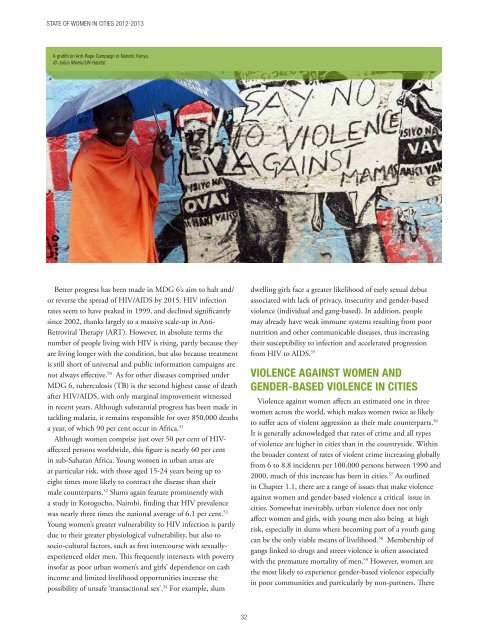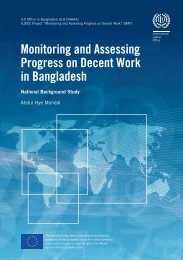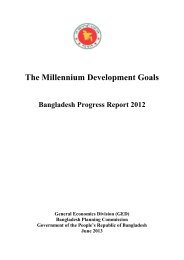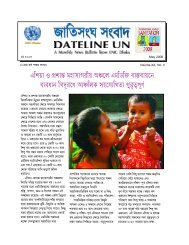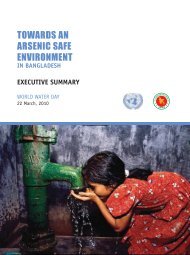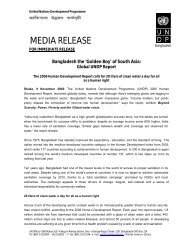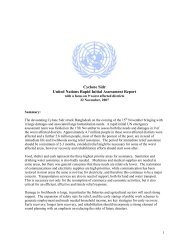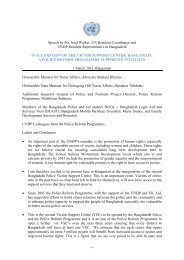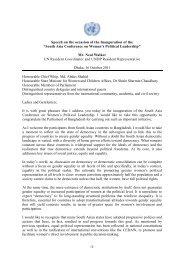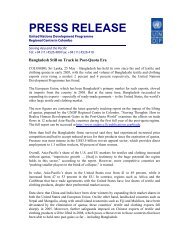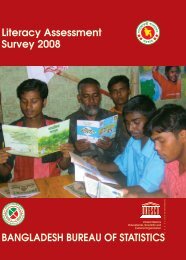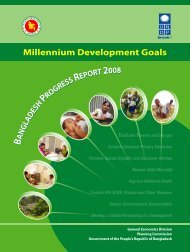STATE OF WOMEN IN CITIES 2012-2013 - UN-Habitat
STATE OF WOMEN IN CITIES 2012-2013 - UN-Habitat
STATE OF WOMEN IN CITIES 2012-2013 - UN-Habitat
Create successful ePaper yourself
Turn your PDF publications into a flip-book with our unique Google optimized e-Paper software.
<strong>STATE</strong> <strong>OF</strong> <strong>WOMEN</strong> <strong>IN</strong> <strong>CITIES</strong> <strong>2012</strong>-<strong>2013</strong><br />
A grafitti on Anti-Rape Campaign in Nairobi, Kenya.<br />
© Julius Mwelu/<strong>UN</strong>-<strong>Habitat</strong><br />
Better progress has been made in MDG 6’s aim to halt and/<br />
or reverse the spread of HIV/AIDS by 2015. HIV infection<br />
rates seem to have peaked in 1999, and declined significantly<br />
since 2002, thanks largely to a massive scale-up in Anti-<br />
Retroviral Therapy (ART). However, in absolute terms the<br />
number of people living with HIV is rising, partly because they<br />
are living longer with the condition, but also because treatment<br />
is still short of universal and public information campaigns are<br />
not always effective. 50 As for other diseases comprised under<br />
MDG 6, tuberculosis (TB) is the second highest cause of death<br />
after HIV/AIDS, with only marginal improvement witnessed<br />
in recent years. Although substantial progress has been made in<br />
tackling malaria, it remains responsible for over 850,000 deaths<br />
a year, of which 90 per cent occur in Africa. 51<br />
Although women comprise just over 50 per cent of HIVaffected<br />
persons worldwide, this figure is nearly 60 per cent<br />
in sub-Saharan Africa. Young women in urban areas are<br />
at particular risk, with those aged 15-24 years being up to<br />
eight times more likely to contract the disease than their<br />
male counterparts. 52 Slums again feature prominently with<br />
a study in Korogocho, Nairobi, finding that HIV prevalence<br />
was nearly three times the national average of 6.1 per cent. 53<br />
Young women’s greater vulnerability to HIV infection is partly<br />
due to their greater physiological vulnerability, but also to<br />
socio-cultural factors, such as first intercourse with sexuallyexperienced<br />
older men. This frequently intersects with poverty<br />
insofar as poor urban women’s and girls’ dependence on cash<br />
income and limited livelihood opportunities increase the<br />
possibility of unsafe ‘transactional sex’. 54 For example, slum<br />
dwelling girls face a greater likelihood of early sexual debut<br />
associated with lack of privacy, insecurity and gender-based<br />
violence (individual and gang-based). In addition, people<br />
may already have weak immune systems resulting from poor<br />
nutrition and other communicable diseases, thus increasing<br />
their susceptibility to infection and accelerated progression<br />
from HIV to AIDS. 55<br />
Violence against women and<br />
gender-based violence in cities<br />
Violence against women affects an estimated one in three<br />
women across the world, which makes women twice as likely<br />
to suffer acts of violent aggression as their male counterparts. 56<br />
It is generally acknowledged that rates of crime and all types<br />
of violence are higher in cities than in the countryside. Within<br />
the broader context of rates of violent crime increasing globally<br />
from 6 to 8.8 incidents per 100,000 persons between 1990 and<br />
2000, much of this increase has been in cities. 57 As outlined<br />
in Chapter 1.1, there are a range of issues that make violence<br />
against women and gender-based violence a critical issue in<br />
cities. Somewhat inevitably, urban violence does not only<br />
affect women and girls, with young men also being at high<br />
risk, especially in slums where becoming part of a youth gang<br />
can be the only viable means of livelihood. 58 Membership of<br />
gangs linked to drugs and street violence is often associated<br />
with the premature mortality of men. 59 However, women are<br />
the most likely to experience gender-based violence especially<br />
in poor communities and particularly by non-partners. There<br />
32


